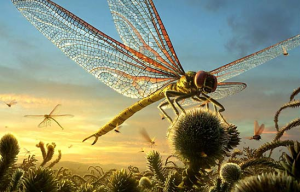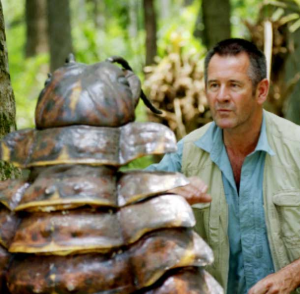Who remembers what Fred Flintstone used for a ball when he played ping pong? That’s right- a pillbug. Pillbugs are harmless little crustacean bugs whose only defense is to roll up into a ball when disturbed. Its hard shelled armor protects it from other insect predators and apparently its balled shape was good for doubling as a ping pong ball for our prehistoric friend. Most pillbugs are about the size of a pencil eraser but not so in the animated cartoon, the pillbug Fred used was much larger (the size of a ‘ping pong ball’) and although this was just a make believe cartoon it was for all intensive purposes most likely correct.
Insects from millions of years ago in the carboniferous period (long before Fred) were actually much larger than they are today. Our cute little pillbug for instance was about 5 feet long and nobody messed with him. Dragon flies were as big as birds and roaches were like small dogs. Can you imagine what life would be like today if insects were still this big? I know I’d need a bigger sprayer. Why then have insects gotten so much smaller? Was this caused by evolution, selective extinction or was it caused by man himself?
I’ve always heard the theory that insects couldn’t get to large because the design of their bodies would not support the weight. I’m sure that’s true of just about everything living. Even extremely big and tall people often have trouble with their legs and backs over time carrying the extra load. At least for mammals, skeletons are on the ‘inside’ of the body so excess growth doesn’t usually make us break. But insects of long ago have been found in fossils and amber that prove they were much larger than today and perhaps puts some of this theory into question. Still, here we are today and the largest insect known today is the Goliath Beetle only weighing at about 71 grams.
What happened?
The theory goes that in the carboniferous period there was much more oxygen available (about 20% more- that’s a lot of oxygen) and this  enabled insects to grow very large. Insects need air just like you and I and breathe using small holes in their bodies called spiracles which lead to trachea. The trachea ( a lung of sorts) then goes throughout the body providing oxygen which enables the bugs to function and live. Just like humans, if deprived of life giving air our bodies wouldn’t function well and growth would most assuredly be affected. Plus, since insects have their skeleton on the outside called an exoskeleton- there’s only so much room inside for all the different muscles, organs, nerves etc. So the tracheas by necessity cannot be that large and this is especially true when it has to fit through the tinier joints of their legs or where body segments come together. So since only so much oxygen can be breathed in and since the content of it in the atmosphere today is less, insects by default are smaller. During the carboniferous period the trachea did not have to be larger but could still carry more 02 so insects thrived and grew.
enabled insects to grow very large. Insects need air just like you and I and breathe using small holes in their bodies called spiracles which lead to trachea. The trachea ( a lung of sorts) then goes throughout the body providing oxygen which enables the bugs to function and live. Just like humans, if deprived of life giving air our bodies wouldn’t function well and growth would most assuredly be affected. Plus, since insects have their skeleton on the outside called an exoskeleton- there’s only so much room inside for all the different muscles, organs, nerves etc. So the tracheas by necessity cannot be that large and this is especially true when it has to fit through the tinier joints of their legs or where body segments come together. So since only so much oxygen can be breathed in and since the content of it in the atmosphere today is less, insects by default are smaller. During the carboniferous period the trachea did not have to be larger but could still carry more 02 so insects thrived and grew.
What Happened To The Oxygen?
At first guess you might say man made c02 brought on the calamity and doomed the insect world to its smaller size. However the carboniferous period was well before even Fred Flintstone and by Freds time insects were smaller already– besides, Fred’s car was powered by his feet and I believe it was a “Prius”-storic vehicle”. 😉 Even in the days of early civilization insects were already at or close to their current size and things like green house gases weren’t even invented yet- well except a good old volcano once in awhile which dwarfs anything we ever put out but, I digress.
In the time of the giant insects it is believed that carbon was filtered and trapped in layers of swampy plants or muck and could not escape. This allowed oxygen to reign supreme and in turn life for the insect was very very good. But when the carbon was let loose the days of the giant bug were numbered and millions of years later all we have is fossils and small bugs. So from the very beginning, the  earth has changed, cycled, evolved or whatever you want to label it and this continues to this day. The bugs don’t seem to be getting any smaller even though some would have you believe we’re doing more to harm the earth than mother nature has herself. I believe even if we tried to correct this supposed problem we wouldn’t make any difference, I mean the bugs wouldn’t get bigger would they? So while the answer to my original question is YES- Climate Change Has Saved Us From Giant Insects. It’s just not the doom and gloomier version of the story but rather the cycle of life and just the natural order of things and I for one say Thank Goodness!
earth has changed, cycled, evolved or whatever you want to label it and this continues to this day. The bugs don’t seem to be getting any smaller even though some would have you believe we’re doing more to harm the earth than mother nature has herself. I believe even if we tried to correct this supposed problem we wouldn’t make any difference, I mean the bugs wouldn’t get bigger would they? So while the answer to my original question is YES- Climate Change Has Saved Us From Giant Insects. It’s just not the doom and gloomier version of the story but rather the cycle of life and just the natural order of things and I for one say Thank Goodness!




